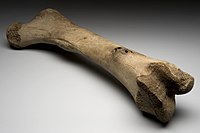
Photo from wikipedia
The assessment of bone structure and metabolism should focus on the bone strength. Many factors are involved, and although bone density is an important component, it is not the same… Click to show full abstract
The assessment of bone structure and metabolism should focus on the bone strength. Many factors are involved, and although bone density is an important component, it is not the same as bone strength. Other aspects of bone quality include bone volume, micro-architecture, material composition, and ability to repair damage. This chapter briefly reviews some of the methods that can be used to assess both density and quality of bone. Non-invasive measurements of density or structure include dual X-ray absorptiometry (DXA), quantitative computed tomography, ultrasound, and magnetic resonance imaging. DXA is most widely used and has advantages of safety and accessibility, but there are limitations in the interpretation of the results, and in clinical practice positioning errors are frequently seen. Invasive methods are used primarily for research. Samples of bone can be used to measure structure by histology as well as micro-computed tomography and infra-red spectroscopy or backscattered electron microscopy. Force can be directly applied to bone samples to measure the bones strength. Impact microindentation is a new minimally invasive technique that measures bone hardness. Metabolic assessment includes blood and urine tests that reflect diseases that cause bone loss, particularly problems with mineral metabolism. Tetracycline-labelled bone biopsies are the standard for measuring bone formation. Non-invasive biochemical tests of bone formation and resorption can evaluate a patient's skeletal physiology.
Journal Title: Handbook of experimental pharmacology
Year Published: 2020
Link to full text (if available)
Share on Social Media: Sign Up to like & get
recommendations!